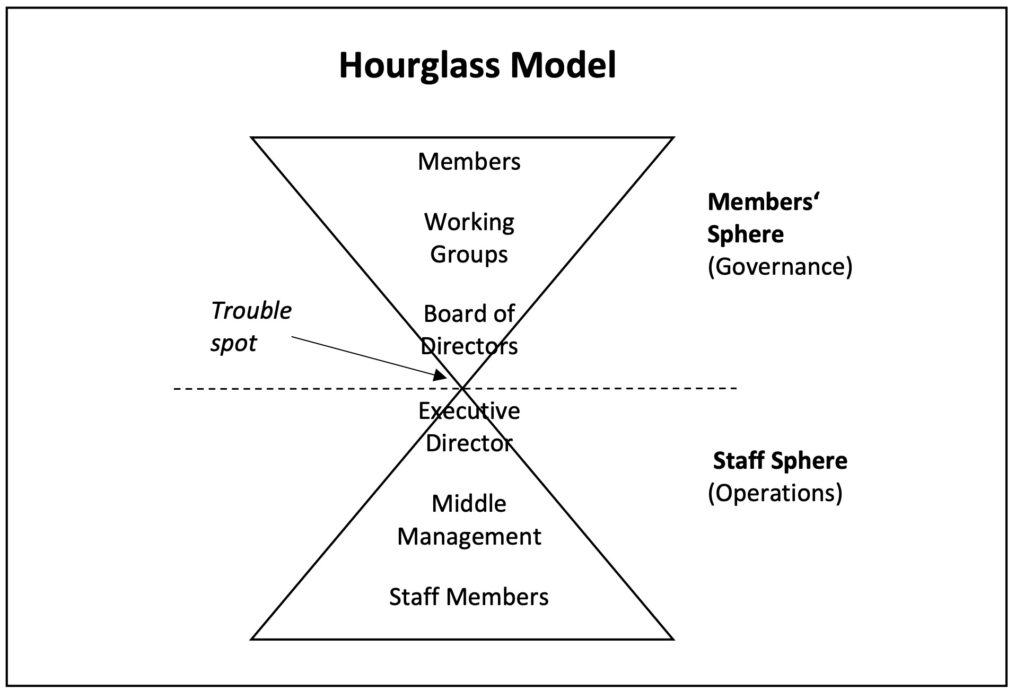Overcoming Design Challenges of Self-Organising Structures

The move to Self-Organisation always involves people stepping up and people letting go. On rare occasions this is played out as a graceful dance that found its time. More likely it comes as a short and juicy clash, or worse, as a long painful drag. In the case I am about to share we were expecting the clash. I very much hope, we are not in for the drag.
I am sitting in a Bucharest Cafe after the Big Showdown that didn’t happen. It is the morning after the Greenfield festival, the annual members gathering of an association I worked with for over 15 years. Greenfield runs multilateral programmes of civic education and environmental awareness throughout Europe and beyond, strengthening and connecting actors across various fields to co-shape positive social development. Over the last years the organisation has grown and developed like mad. Today Greenfield has about 1500 members in 20 countries and an international staff of 40 people working from a Berlin office. I love this organisation with its dedicated people and its dynamic drive and I really want it to be healthy.
(Side-note: There is a case to be made for processes in which you are a familiar face. Classically, OD consultancy requires a half-in-half-out facilitator position in which you are able to dock on but at the same time bring enough outside perspective to the table. Sometimes, when you have worked with a client for too long, that’s not the case anymore and you ought to step back. In rare and precious occasions, it is exactly the delicate insider knowledge (coupled with a clearly marked facilitator role) that brings things forward. In my experience it is particularly complex settings that call for this insider-position. The unknown, incomprehensible is not confined to the environment any longer but has entered the city walls and dwells inside).
The task I was trusted with was to facilitate a governance reform that should propose a bold new model of decision making while leaving the Greenfield spirit intact (a bit of a mixed message, but worth a try). The bulk of development work was done by a small mandated cross-functional group during several retreats and online sprints over the last year. It was an intimate and quite effective process that led us through a rollercoaster journey: driving loops of interviews, stakeholder meetings and consultations with existing governance bodies, crafting alternatives, falling in love with them and letting them die again, developing personas to collect points of view and “test drive” the model from their perspective.
The key problem we set out to tackle was the split between formal and informal decision arenas: people who were formally accountable (most notably the elected board) were not actually the ones in charge, while people who were factually taking charge (most notably programme executives with partner organisations in the field) did not have a voice in the formal governance routines. To make things a bit more challenging, the process was over-layered by a major funding crisis with multi million Euro cuts due to the strategic reorientation of a major funder. In a way, we were looking for an elegant way for Greenfield to survive and come out stronger from this crisis.
Our first struggle was to overcome the design convention that governance and creation of impact should not be co-located. The classic view of an association looks like an hourglass: On the upper end is a sphere of members’ deliberation, funnelled into a board of directors that interfaces in the hourglass bottleneck with the executive directors on the operative lower half of the structure – the business or programme sphere. (By the way, I think this bottleneck accounts for at least half of the governance problems we find in classic associations). While the members’ sphere is all about democratic process associated with higher level (strategic) governance, the sphere of programmes is about creating impact, associated with lower level (operational) decisions.

(after: 2004 Christian Koch und Thomas von Holt, Bonn)
This division derives from an old-fashioned view of “good governance” and is somewhat impractical, to say the least. In contrast, self-organised and cooperative working models require that impact creation and governance be placed in the same hands. In consequence, we looked for ways to give all parties creating impact a voice in the governance system and to enable all parties with a stake in governance to contribute to the impact of Greenfield. The shelves of the German legal system are not necessarily stacked with formats to serve such an idea and it soon became obvious we would need to do some hacking of legal structures.
We all agreed that the natural impulse to re-establish order by giving the power back to formal decision makers and putting a lid on renegade programme autonomy was not the way forward. Recognizing that programme staff as well as some members’ and alumni groups were already self-organising around fields of impact, proposed a reality that needed to be honoured, not cut back. The old Gestalt wisdom rang true: Only when you become what you really are you can start to change. In effect, the second cut with conventional wisdom was to go with the Desire Path approach: find traces of organisational behaviour; decode the motives behind them; honour the motives in the design of the new formal processes and structures; make way for things to find a new groove.
The model we came up with in the development process was simple but full of implications: It was based on the idea of Loose Coupling. Instead of an association with individual membership, we proposed Greenfield to become a network association with institutional members – a shared platform in which programme clusters as well as sub-groups of members and partner organisations could join forces to share knowledge and create impact. The governance would follow a decentralised logic with a Council overseeing the integrative functions of the network. The “market place” – shared infrastructure and joint commoning practices – would be hosted by a lean professional backbone team. To create a membrane around the association, the model proposed a Community Membership for individuals which did not imply a legal status but simply signified a commitment to values and mission of Greenfield and granted low threshold access to the Commons. Wherever people would feel inspired to interact around certain issues of development, exchange or learning they could do so in the format of “Circles” – a practice of regular but dynamic self-organised meetings. Circles, as well as institutional members would be represented in the Council. The model conceptualised Greenfield as an ecosystem with a minimal structural base and a great procedural dynamic.
After one year of drafting work in the development group and a number of consultative loops it was time to bring our proposal to the General Assembly – Showtime in Bucharest. The clash we expected was due to the fact that the current members would essentially have to vote themselves out – handing over their deliberation power to a new body that yet had to be crafted. A leap of faith, even for people on board with the decentralised network idea. Surprisingly, the Big Bang did not happen. Despite some very heated discussions throughout the festival, the model was almost unanimously endorsed by the members.
The discussions we had circled around three main issues:
Stability of Loosely Coupled Systems
Will loose coupling make the organisation stronger or more vulnerable? How big is the risk of drifting apart? How strong will the commitment of one programme cluster be to help out another cluster in need?
In order to trust the model, it is necessary to shift our understanding from static to dynamic stability. While the classic idea of stability is associated with tight coupling (things are mounted together so tightly that they can weather any storm), there is another kind of stability which is associated with the ability to bend rather than break (note: static stability implies brittleness): Reeds are dynamically stable, so are high tech construction materials that work with moving undergrounds. In organisations, dynamic stability is effected by loose coupling of subsystems. Loose coupling means that units are not tied together by command and control but rather by lateral coordination and negotiation. Instead of static rules and regulations they are coordinated by principles. If an organisation has to adhere to highly conflicting stakeholder spheres or is exposed to very turbulent environments, loose coupling is the way to secure adaptive integration. One step beyond, Taleb’s concept of “Antifragility” adds the ideas of resilience and learning to the equation: Loose coupling prevents knock on effects in local crises (which is not to say it rules out solidarity and commitment for mutual support). If managed effectively, local crises can even become learning arenas for the whole organisation, thus making it stronger under stress (the idea of “Antifragility”). Finally, loose coupling supports organisational diversity, another key aspect of resilience – both in terms of sensory input filtering and problem solving. It is obvious that these positive effects require a careful structuring of the loose coupling mechanisms. Without the proper communication channels and practices, a loosely coupled system is not more sensitive but has fragmented vision. Without shared principles the negotiated coordination is not more stable but vulnerable to be blown apart when the weather gets rough.
Viability of Process Based (dynamic) Governance
How can representatives of semi-formal dynamic structures be mandated? Will the new model be super complicated, redundant and messy? Will institutional members dominate the network governance?
Process based representation is still a young field in the domain of organisational governance. The models we know feel ambiguous and seem to invite micro-political activity. Indeed, they do. An under-structured system (just as much as an over-structured one) is a great breeding ground for micro-politics. While the term has a somewhat problematic connotation in classical organisation design, micro politics is what self-organisation is all about: people taking charge and being politically active for their issues – in any part of the system, at any time in the process. The bad reputation of micro-politics may be due to our problematic relationship to power (I say “our” well aware that there are a bunch of people who have worked their way out of this relationship, as well as some who never entered it). If micro-politics is translated as tactical power play, we quickly conjure up images of greedy, self-interested mini Mafiosi and power hungry warlords. Yet, power – the ability for joint action – in its pure form is far from just that.
The term “dynamic governance” has found its most prominent use in describing the Sociocratic and Holacratic Models. The way I use the term here is compatible but not bound to the overall architecture these models imply. In the static governance approach, subsystems are represented by delegates or leaders in a higher level decision making body. These representatives may change in a given rhythm of tenure but the subsystems are more or less static (a membership body, a regional division or functional department etc.).
Dynamic governance in turn implies that the structuring of subsystems itself is fluid. The switch from a department to a project based logic has introduced such a turn towards fluidity in many contemporary organisations. The idea of Circles proposes another switch with even more far reaching implications as Circles are self-mandated rather than strategically launched. When projects or Circles are not just self-managed but are represented in higher level decision making bodies by delegates, we are looking at dynamic governance. Obviously such a practice causes challenges: Can any self-mandated circle demand representation or is there is filter? How does an individual delegate get the insights to contribute to overall decisions beyond his or her field of action? How does a governance body develop a collective problem solving potential if members are constantly changing? Can there be a fusion of static and dynamic governance and will this not lead to dominance of the long term (institutional) representatives?
The answers to these questions have to be developed case by case. One major point needs to be made though: What constitutes a “higher level” decision arena may just be the first idea we need to challenge. In the self-organising, cooperative models the bulk of power is handed to the individual units “on the ground”. The higher levels are not deciding on strategic frameworks or operational directives for the units (the “deductive policy approach”) but are arenas of coordination and negotiation in which these frameworks and directives emerge inductively.
The Hollow Centre
What if things drift apart? What if the Tragedy of the Commons takes hold of us? What if the Centre will be empty?
In the “Unbearable Lightness of Being”, Milan Kundera famously described two pathways of identity formation: “Addition” and “Subtraction”. The adding approach is about embracing traits, habits and things that define who I am: the guy with the Clark Gable moustache, the lady with the Siamese cat, the boy who can walk on his hands… I become who I am by adding features. The opposite approach – subtraction – is about stripping away (superficial) defining features in order to find my true self underneath. I look beyond the moustache, the cat, the acrobatic skill to find my naked truth, my innermost self. Kundera’s Nightmare: What if we find that after stripping away all the added layers that define us, underneath the last skin we find nothing? What if the core is hollow?
The idea of Commons has been a fascinating and problematic one. Plainly defined, commons are the parts of a social system that don’t fall under any individual responsibility and ownership but are owned collectively. The most frequent experience with commons is that they are in bad shape: Piles of dirty dishes in the collective kitchen sink are the classic example, universal tax evasion is another. Economic theory has long assumed that Rational Choice is the foundation of human behaviour and has explained the “Tragedy of the Commons” as a logical consequence of unfavourable payoff structures (why should I do the dishes, if my costs for doing so are not matched by the promise of a personal surplus benefit?). It was not till quite recently that the discourse opened up to acknowledge another version of the story: Embeddedness. In 2009 Elinor Ostrom received the Nobel Price in Economy for her work on Commons that actually work – most notably fishery communities in Scandinavia. Ostrom shows that commons are not destined to fail – however, their health depends on a small set of conditions which she laid out in eight principles:
Principles for Managing a Commons
- Define clear group boundaries: a membrane that signifies who is part of the community creates the container needed for the following principles to flourish.
- Match rules to local needs and conditions: rather than universal regulations a locally crafted set of agreements has a higher effectiveness and identification potential.
- Ensure that those affected can participate in modifying the rules: when people know they can influence the rules of the game, they have a bigger commitment to honouring them.
- Make sure that self-organisation is respected by outside authorities: local self-regulation works best if the institutional environment honours the community’s sovereignty and does not interfere with it.
- Develop a system for peer monitoring: if no one witnesses me leaving my cup in the sink and no one acknowledges me doing the dishes, things are a lot harder than when these are public acts.
- Use graduated sanctions for rule violators: A rule system without consequences is a toothless tiger.
- Provide accessible means for dispute resolution: rules protecting the common interest have the tendency to get in the way of individual interests. This tension needs a continuous negotiation arena.
- Build responsibility in nested tiers from the lowest level up to the entire system: large groups don’t fare very well on collective responsibility and peer monitoring. Smaller sub groupings that are connected to form a bottom up hierarchy are much better suited for this.
In my experience, there is another condition for a flourishing Commons that is procedural and has less to do with rules then with engagement: The practice of “Commoning” is modulated by reinforcing feedback loops. If many members are engaging in the commons, it seems fun, rewarding and the thing to do. Livelihood breeds livelihood. The reinforcing feedback loop spirals up. If few people engage, those committed feel used and awkward and may dampen their engagement – decay breeds decay: the system spirals down. How can we hotwire and stimulate these cycles to spiral up rather than down? By offering regular but low threshold points of engagement. Not as a service and not just as a platform, but as a promise.

